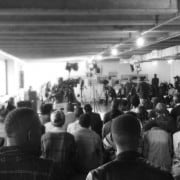|
Getting your Trinity Audio player ready...
|
 By Nicky Rehbock
By Nicky Rehbock
Knowing how our organisation works, using real incidents reported to us by the public, helps to show how we treat all cases from the public equally – whether they involve the abuse of public resources or power in a government department, private company, NGO or union.
Broadly speaking, there are two very separate elements to Corruption Watch – our board and then the organisation itself.
The nine board members drive the vision of the organisation, help ensure Corruption Watch fulfils its mandate and is financially sound. With the exception of David Lewis, the executive director, no board member is involved in day-to-day operational matters. The board meets quarterly to review the strategic direction of the organisation – individual cases are never discussed with board members.
This set-up is in contrast to the operational side of Corruption Watch, made up of non-partisan admin staff, journalists, investigators, lawyers, researchers and data specialists. We’re just over 20 members in total.
The organisation receives, on average, over 200 reports from the public a month and more than seven reports per day. These are logged through our incident reporter tool on our website, or by SMS, email, post, fax, social media or landline calls. We also take reports from people who visit our offices in person to report an incident.
Three examples of widely publicised cases which began as a single report at Corruption Watch are:
- The Mvula Trust scandal
- Firing of North West education department’s Abe Seakamela
- Abusive Mmutle school principal, Charles Modjadji
All reports we receive are recorded by our data managers and entered into our online case management system.
We acknowledge receipt if the complainant has provided us with contact details.
At a weekly meeting of the legal, investigations and media teams, reports are analysed, debated and then assigned to an appropriate division. In order for a report to be acted on, it needs to meet certain criteria – this includes:
- The corruption occurred post January 2012.
- The complaint is about the abuse of public resources and/or public power.
- There are contact details of the complainant or sufficient information within the report to enable Corruption Watch to follow up on the matter.
- Corruption Watch’s investigation will add value to a case that is being handled by another agency.
- We have the financial and human resource capacity to take the matter further.
So what do we do with the reports?
Reports are handled in various ways – often the nature of the information they contain dictates the appropriate course of action to be followed. The possibilities include :
- Using the reports to drive our advocacy work and campaigns. For example, we used all cases involving bribery on the roads to confront the City of Joburg and the Joburg Metro Police Department to advocate for tougher action against corrupt cops. This fell under our No More Tjo-Tjo campaign.
- Publishing reports on our website so that other people who have knowledge of similar incidents can read them and report further.
- Using the incident as the basis for a news story, an example of this is us exposing abusive Mmutle school principal Charles Modjadji.
- Asking for more information from the person who reported the incident to us – once we get that additional information, we have a better idea of where to assign the case.
- Starting a formal investigation – the Mvula saga is an example of a report which spurred a four-month investigation here at Corruption Watch. The findings were then referred to a government department, which in turn initiated its own probe. See the next section for more details on this.
- Referring the incident to a journalist to expose in the mainstream media – examples of such cases are the Mvula saga and the firing of North West education department’s Abe Seakamela.
- Referring the incident to a government authority for investigation (such as the Independent Police Investigative Directorate or Public Protector).
- Taking some kind of legal or policy-based action based on the reported incident. For example, Corruption Watch wrote a letter to Gauteng legislature speaker Lindiwe Maseko last year asking her to respond to allegations of corrupt behaviour. A formal investigation was launched by the Gauteng integrity commissioner and its ethics committee, but she was cleared of wrongdoing.
Timeline of Mvula saga
Still confused about how individual cases become mainstream media exposés? Let’s look at the Mvula saga in a little more detail:
2011 – Department of Cooperative Governance and Traditional Affairs (Cogta) awards R30-million tender to Mvula Trust to implement a job-creation project. In November that year it emerges that a private company connected to Mvula trustees was appointed to partner with Mvula in rolling out the project. One long-serving Mvula trustee walks out after hearing this news and reports tender irregularities to the police. Case is opened and referred to the commercial crimes unit for investigation.
Mid-2012 – Whistleblower approaches Corruption Watch and reports knowledge of corruption surrounding the trust. The report is assigned to one of our investigators for further probing – an in-depth process which took four months. Investigator compiles a comprehensive report with key findings and recommendations.
Late January 2013 – Corruption Watch hands over completed investigation to Cogta and partners with the Daily Maverick to expose the findings. We issue a press release to ensure the story is picked up by mainstream media. We publish the exposé on our own website too and promote through our social media channels. Corruption Watch hears nothing from Cogta at this stage, while Mvula issues a press statement denying claims made in the exposé.
13 February 2013 – News breaks that Mvula has fired its acting CEO Silas Mbedzi without having a replacement lined up.
1 March – Beneficiaries of the job-creation project, which Mvula was appointed to manage, arrive at the trust’s offices in Joburg CBD, demanding their wages. Some say they haven’t been paid in months.
8 March – Corruption Watch issues a press release putting pressure on Cogta to look into the findings of our probe, particularly in light of news that the poorest of the poor – those who were supposed to be beneficiaries of the job-creation project – are not being paid.
11 March – Cogta minister Richard Baloyi, in a bizarre media interview, distances himself and his department from goings-on at Mvula and the non-payment of beneficiaries. But puts on record that he will make time to discuss the details of Mvula’s seemingly dodgy R30-million tender.
25 March – Baloyi makes good on his promise and grants Daily Maverick reporter Alex Eliseev an exclusive interview to discuss the saga – it’s during this exchange that he announces a full-scale investigation into the awarding of the Mvula tender is under way at his department.
10 April – Details of Cogta’s investigation are leaked to Corruption Watch – it seems this probe is being overseen by an in-house municipal agent which reports to Cogta – and not by a more appropriate inter-ministerial committee. Corruption Watch issues a press release stressing its concern over the choice of entity chosen to oversee the probe and calls for the investigation to be conducted transparently, the outcome to be made public and there to be real consequences to the findings.






